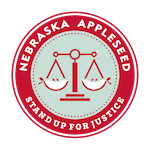There is a saying around the Capitol that our state budget is a moral document. It reflects the priorities of Nebraskans and where and in what we want to invest in our communities. The start of the 2025 budget process kicked off this week when state agencies had to put forward their agency requests for funding for the next two year cycle.1
While we’ve seen some distressing things recommended by agencies in the past, this year‘s agency request from the Department of Health and Human Services (DHHS) made us incredibly concerned. Our staff at Appleseed is still continuing to review the 1800+ page document, but we wanted to highlight some of the more egregious proposals that are being outlined in this year‘s agency request.
Before we detail those specifics, however, we wanted to note that this is just the start of the budget process. Just because an agency proposes these different items in their initial budget request does not mean that all of these items will be adopted by the Governor or by the Legislature as the budget process moves forward.
That said, now is the time to start advocating to the Governor and to your state senator to preserve these programs and not to enact cuts that would target the most vulnerable populations in our state. This is especially important given the recent $40 million cuts the Legislature made to DHHS’ budget in the special session. We cannot let this continue and still see healthy, thriving communities across our state.
Health Care
The biggest proposed cut – and the number one priority of recommended cuts DHHS has named in terms of impacts to aid – is to eliminate all of Medicaid’s optional services for the adult population.2 This would mean that adult Medicaid patients would no longer be able to access services like dental care, coverage for prescriptions, mental health services, cancer screenings, non-emergency transportation, and physical or occupational therapies, among others. This would have devastating effects for those Medicaid recipients, on the healthcare system as a whole, and on the state’s overall well being.3 As just one example, a patient could still see a doctor but would not have insurance coverage for any prescription the doctor prescribes.
There is an additional recommendation to eliminate the current Aged, Blind, and Disabled Medicaid category which currently provides financial and medical assistance to those over 65 or older, or 64 and under who are blind or have disabilities.4 DHHS does note that adopting this proposal would put the state’s entirety of its Medicaid federal funding in jeopardy. It would also put some of our most vulnerable community members in an impossible position if these supports are eliminated.
DHHS is also proposing to cut already underfunded provider rates for Medicaid services by 5% across the board. Lowering these rates would lead to fewer providers accepting Medicaid recipients and would hinder access to care. The Department also recommends closing down two external call centers that help ensure that Medicaid applications are processed in a timely manner and that any questions from Medicaid applicants are addressed.
Child Welfare & Economic Assistance
One concerning recommendation in the child welfare and economic assistance budgets is the proposal to reduce staff from both divisions.5 We know that our DHHS caseworkers work hard to keep families safe and to ensure that those who need assistance are able to receive it in a timely manner. However, cutting as many staff as is proposed in this agency budget would further stretch an already overstretched system.
But perhaps the most potentially impactful recommendation with regards to these two programs is the proposal to reduce the overall budget for Nebraska’s child welfare system by 10%.6 DHHS notes in this recommendation that this cut would present numerous challenges to a system that is constantly seeing high case counts, including difficulties finding permanency for families in the system. Nebraska’s child welfare system must ensure families receive the support they need to be strong, safe, and healthy. A 10% cut to the child welfare system budget cannot support this important aim.
Although the DHHS budget is simply a broad blueprint, it reflects an upside down set of priorities that would harm our friends, family and neighbors. As we approach the Legislative session, it will be crucial to track the legislation and budget that will be proposed to ensure these draconian proposals do not become a cruel reality in our state.
Be sure to follow Appleseed for updates as the budget process continues to evolve.
- https://das-nebs.ne.gov/public/faces/brdIndex.jsp; see 025 DEPT OF HEALTH & HUMAN SERVICES ↩︎
- Pg. 374 ↩︎
- DHHS acknowledges in the proposal that “[t]his modification would have a detrimental impact on clients and/or populations that will no longer receive these services.” Pg. 374 ↩︎
- Pg. 379 ↩︎
- Pg. 359 ↩︎
- Pg. 394 ↩︎


